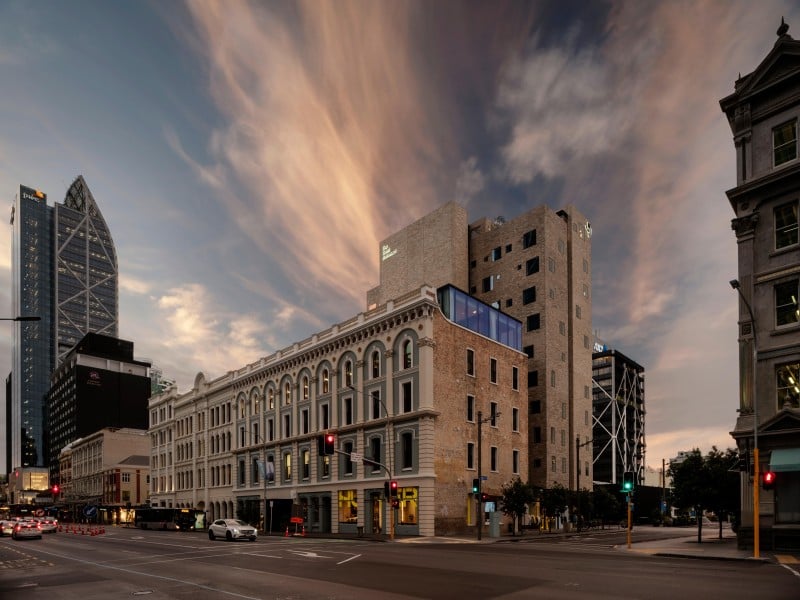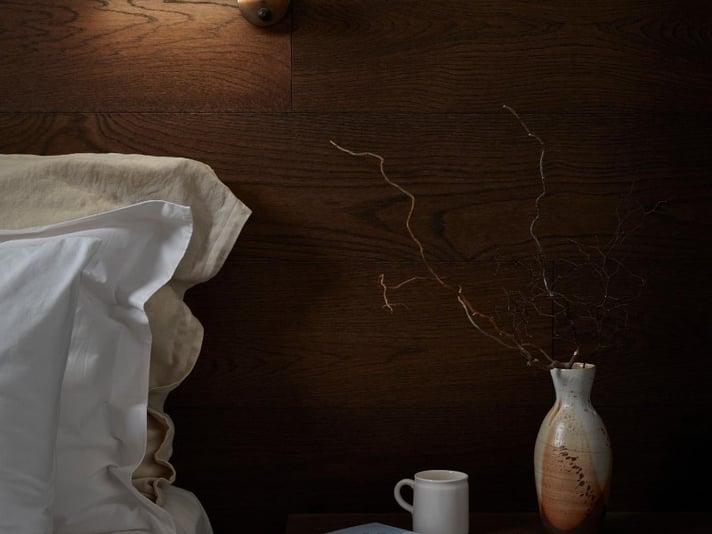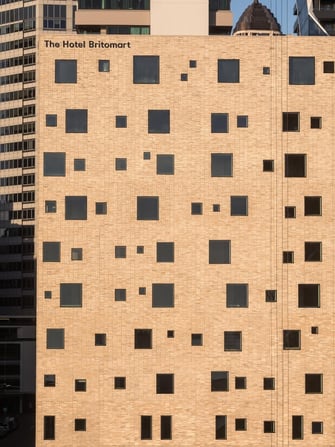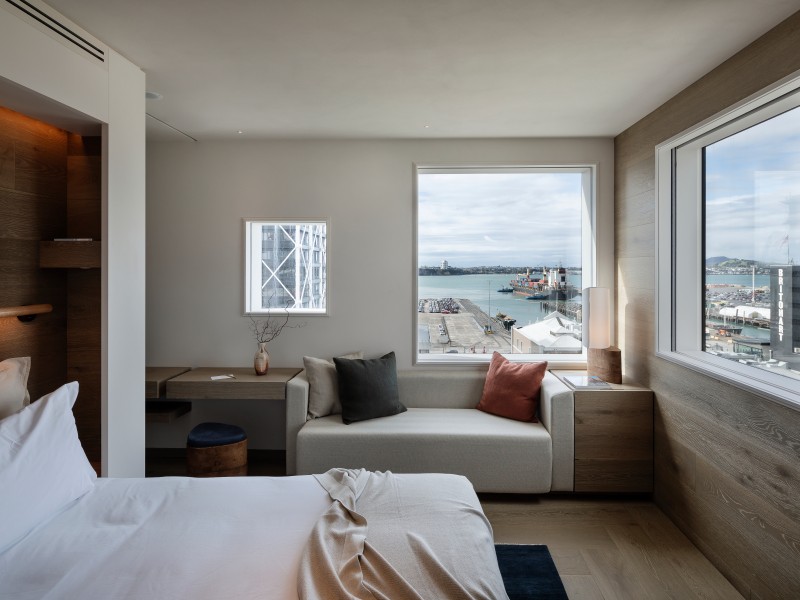5 Star treatment: The Hotel Britomart is officially Aotearoa’s first Green Star hotel
Essentials
What: The Hotel Britomart
Where: 29 Galway Street, Britomart, Auckland
The Building: 11 floor boutique hotel sited in the hub of Auckland’s dynamic Britomart precinct.
Highlights: A striking exterior featuring 150,000 handmade bricks and an irregular assemblage of square windows. The hotel development includes the refurbishment of two adjoining heritage buildings, Masonic House and Buckland Building, and a new public laneway connecting Galway and Customs Streets.
Occupancy: 104 rooms to cater to 208 guests. 55 employees work across the hotel and kingi restaurant in adjacent Masonic House.
Project Snapshot
Owner: Cooper and Company
Architect: Cheshire Architects
Main contractor: Bracewell Construction
Project manager: TSA
Building services engineer: Norman Disney & Young
GSAP: Hayley Koerbin, Norman Disney & Young
Project status: Two year build, opened September 2020
Project cost: $50 million
Project certification: 5 Green Star Custom Built rating

Building a brand-new hotel which does the right thing by the planet and the people inside its walls could be construed as lofty green talk.
But Cooper and Company, the private investment company behind the resurgence of Auckland’s world-class waterfront Britomart precinct and the owners of Aotearoa’s first Green Star rated hotel, isn’t in the habit of saying and not doing.
“We all have an obligation to step up and work harder to stop the demise of the environment,” says Campbell Williamson, Cooper and Company’s development director.
“This premise drove the design and build of The Hotel Britomart. Using the Green Star tool brought discipline to the project and our 5 Green Star certification has formalised that we’ve done the right thing for the Earth, our staff and our guests.”
From the outset Cooper and Company has viewed Britomart through a green lens and has been a property industry trailblazer with its adoption of the Green Star Performance tool to assess the operation of a raft of buildings in its Britomart portfolio.
When the concept of a boutique hotel in Britomart landed on the drawing board, multifaceted green thinking led the conversation.
“Collaboration was absolutely essential to this project and to our delivery of a truly green building because we were stepping outside the square with our approach. Green Star is not yet the norm in the New Zealand construction industry but as the sector matures and gives the environment more priority in the equation, Green Star certification will undoubtably become the benchmark,” says Campbell.
He says designing and constructing an authentic green building required intense scrutiny to ensure all materials, products, systems and supply chains were not only green-rated but that all alternatives were compatible.

“For example, we chose a Green Star-approved timber veneer for the hotel doors but then discovered the wood stain didn’t meet the required Green Star standards. Changing the stain meant revisiting colour palates - no small task - which in turn led to a conflict with the polyurethane finish and the provision of warranties. The resolve involved minimal material cost difference but caused a four-week delay to that workstream.”
Campbell says additional direct costs associated with the green build were around $200,000 - “a small value in the wider scheme of things and a reassurance to our company of the ‘business-as-usual’ focus on sustainability’” – while project management fees were bumped up by $500,000 due to the demands of extra research, checking, documentation and auditing.
“It’s a cost Cooper and Company was happy to take on as a contribution to helping lift the construction industry until green building becomes an industry norm and these research and checking costs will no longer be required.”
He says Green Star has added interest at every level.
“I think our guests are now more aware of their own personal and business impact on the environment. Being Green Star certified and using the Green Star Performance tool provides a high level of assurance and transparency that every element of the hotel’s operation has a clear intent and outcome relating to a positive impact on the environment,” Campbell says.
Cheshire Architects principal and co-designer of The Hotel Britomart, Dajiang Tai, says bringing a sense of craftsmanship back to a large-scale commercial development, amplifying the dynamic language of Britomart and becoming the first 5 Green Star rated hotel in New Zealand drove his architectural brief.

Fully integrated room control systems allowing remote control of blinds and air conditioning, compact hotel rooms and an absence of full-height windows were implicit in the building’s design.
“We wanted the new building to sit nicely amongst the heritage buildings with a weight and solidness which differs from other fully glazed buildings. And we wanted to cut down the heat gain in rooms and frame specific views,” says Dajiang.
A major adapt and re-use part of the project was The Libraries on the first of the Masonic Buckland building.
"Extending the life of the heritage building was a big part of the design intent. Instead of demolishing the existing heritage fabric, we kept the existing shell as much as possible, and have only done a few big moves such as lowering the ground floor and relocating the building core to adapt the building for modern commercial use. The shell with its layers of history is then showcased to the public and becomes a place to house exquisite crafted objects or art,offices and function rooms."
He says the hotel’s Green Star rating delivers a positive message to the construction industry.

“It shows not only what architects are caring about at the moment, but a Green Star rating also demonstrates what the future of building means.”
The Hotel Britomart was building contractor Bracewell Construction’s first involvement with Green Star and while the project was a learning curve for staff and subcontractors, site work proceeded smoothly once everyone understood the sustainability and environmental targets.
“The Green Star criteria meant we all had to think hard about the products we were installing – where were they sourced from, how were they manufactured, what was their long-term impact on the hotel?” says Bracewell quantity surveyor, Neil Deason.
Neil says to achieve a 5 Green Star rating while overcoming the construction restraints of a small inner-city site, a highly detailed structural and architectural design, and the installation of a unique exterior cladding system has been a major triumph.
The hotel’s fantastic 5 Green Star rating also demonstrates the client and project team’s commitment to sustainable outcomes says GSAP and New Zealand Sustainability Lead at Norman Disney & Young, Hayley Koerbin.
“The targeted Green Star rating lent a rigour to every design and procurement decision and inspired suppliers to aim higher with their own products to fit the aims of the hotel project,” says Hayley.
She says beyond Green Star the hotel has committed to reducing its environment impact across the board with 100% organic eco-cotton sheets and towels which can be composted at end of life, pillows, duvets and protectors filled with a luxury microfibre derived from recycled plastic bottles and only locally sourced packaging in guest room minibars.
“Travellers would typically expect eco-friendly accommodation to be in more rural settings, surrounded by nature so to provide a sustainable option right in the central business district is a testament to the project. I hope other hotel operators see The Hotel Britomart as a benchmark for their future developments,” she says.

One Hawke’s Bay guest, Lesley Andrews, who returns to The Hotel Britomart on a regular basis, says the building exudes a sense of wellness and sustainability not found in regular hotel accommodation.
“Initially I spent some time looking up at the outside of the hotel trying to find a pattern in the constellation of windows and then trying to find a rhythm in the way the hand-developed bricks stack. Even before entering it’s obvious the building is well considered.”
“It’s a trove of natural materials, ceramics, textiles, books and care products by local and Aotearoa-based artisans. Lighting is important to me and thoughtful natural light is evident everywhere in the hotel. Staying at The Hotel Britomart is without compromise to my usual efforts toward sustainability,” Lesley says.
Green features include:
|
Technical features include:
Innovation points awarded to the project include:
|
